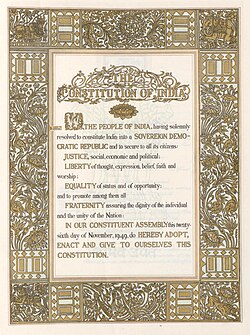| Republic Day of India | |
|---|---|
 The original text of the Preamble to the Constitution of India. The Constitution of India came into force on 26 January 1950. | |
| Observed by | Republic of India |
| Type | Public |
| Significance | Commemorates the adoption of India’s Constitution |
| Celebrations | Parades, speeches and cultural events etc. |
| Date | 26 January |
| Next time | 26 January 2026 |
| Frequency | Annual |
| First time | 26 January 1950 |
| Part of the Politics series on |
| Republicanism |
|---|
| |
Republic Day is a national holiday in India commemorating the adoption of the Constitution of the Republic of India and the country's transition to a republic which came into effect on 26 January 1950.
Contents
- Background
- Customs and celebrations
- Parade
- Flypast
- Beating retreat
- Awards
- Gallery
- See also
- References
- External links
The constitution replaced the Government of India Act 1935 as the governing document of India, thus turning the nation from a dominion into a republic, following its independence from the British Raj in 1947. The constitution was adopted by the Constituent Assembly of India on 26 November 1949 and came into effect on 26 January 1950. The date was chosen because the Indian National Congress had proclaimed Purna Swaraj (complete independence) on that date in 1930.
Republic Day is commonly associated with parades, political speeches, cultural events and ceremonies, in addition to various other public and private events celebrating the history, government, and the traditions of India.









